The strongest typhoon to hit China in half a century killed more than 100 people, dozens of whom had taken shelter in a house that collapsed, Xinhua news agency said yesterday, and the toll appeared likely to rise.
Typhoon Saomai tore into Cangnan County in Zhejiang Province on Thursday after authorities moved more than 1 million people in the densely populated commercial province to safety.
By noon yesterday, 104 people were confirmed dead and 190 were missing in Zhejiang and neighboring Fujian Province, Xinhua said. Some 54,000 houses were destroyed.
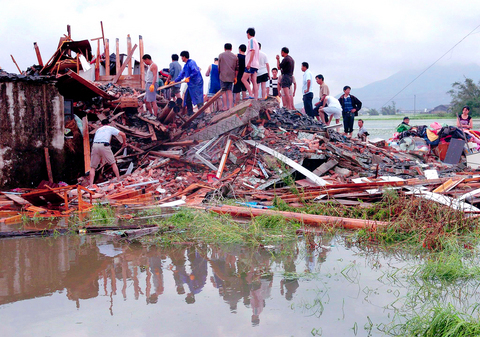
PHOTO: EPA
At least 41 villagers, including eight children, were killed when a house collapsed in the town of Jinxiang, only an hour's drive from where the typhoon made landfall, Xinhua and a local official said.
Most of the victims were neighbors who thought the two-story, concrete structure would be safer than their own wood-and-brick shelters, Xinhua said, adding another two died in a separate house collapse in the town.
"Many people here are taking shelter in schools and factories as their houses have been destroyed," the official in Jinxiang said.
Damage to crops, power lines and infrastructure was evident in Cangnan County.
"Lots of people were hurt here but my family are all okay," said Wu Yelian, an old woman doing a roaring trade in instant noodles and canned drinks to drivers stuck in the heat in a jam on the narrow mountain road outside. "I haven't seen a typhoon this strong in years. Last time we had a bad one, a dam collapsed and many people died."
Power was also cut in five towns close to where Saomai made landfall, Xinhua said.
Along a highway in Cangnan, trees were knocked flat, their branches and tops ripped off. Tiles and even bricks from flimsy farm houses lay strewn about on the ground. Power was cut and fixed telephone lines were knocked down.
Eight Taiwanese sailors were also rescued after two ships capsized on Thursday in a harbor in Fujian, while four Chinese were saved after their ship struck a reef, according to Xinhua.
The typhoon crossed the coast with winds of 216kph -- more powerful than a typhoon that hit Zhejiang in August 1956, killing more than 3,000 people.
Saomai was the eighth storm to hit China this year. Tropical Storm Risk had graded Saomai a maximum Category 5 "super typhoon," but reduced that to Category 4 as it made landfall, the same category as Hurricane Katrina which devastated the US Gulf coast last year.
Much of south China has been battered by typhoons and tropical storms this summer. Nearly 1,000 people have been killed by rainstorms, mudslides, house collapses and floods.
Tropical Storm Bilis killed at least 637 people in China last month and Typhoon Prapiroon killed about 80 last week.
By yesterday morning, Saomai had weakened into a tropical depression and moved inland.
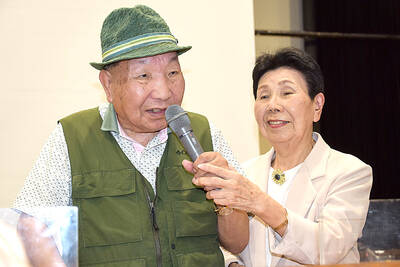
DEATH CONSTANTLY LOOMING: Decades of detention took a major toll on Iwao Hakamada’s mental health, his lawyers describing him as ‘living in a world of fantasy’ A Japanese man wrongly convicted of murder who was the world’s longest-serving death row inmate has been awarded US$1.44 million in compensation, an official said yesterday. The payout represents ¥12,500 (US$83) for each day of the more than four decades that Iwao Hakamada spent in detention, most of it on death row when each day could have been his last. It is a record for compensation of this kind, Japanese media said. The former boxer, now 89, was exonerated last year of a 1966 quadruple murder after a tireless campaign by his sister and others. The case sparked scrutiny of the justice system in
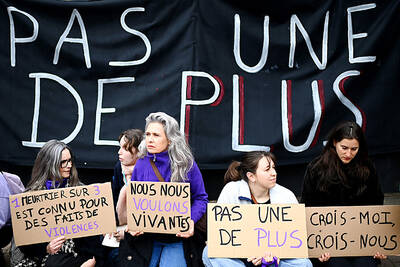
A French-Algerian man went on trial in France on Monday for burning to death his wife in 2021, a case that shocked the public and sparked heavy criticism of police for failing to take adequate measures to protect her. Mounir Boutaa, now 48, stalked his Algerian-born wife Chahinez Daoud following their separation, and even bought a van he parked outside her house near Bordeaux in southwestern France, which he used to watch her without being detected. On May 4, 2021, he attacked her in the street, shot her in both legs, poured gasoline on her and set her on fire. A neighbor hearing
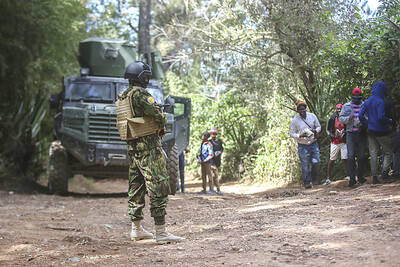
DITCH TACTICS: Kenyan officers were on their way to rescue Haitian police stuck in a ditch suspected to have been deliberately dug by Haitian gang members A Kenyan policeman deployed in Haiti has gone missing after violent gangs attacked a group of officers on a rescue mission, a UN-backed multinational security mission said in a statement yesterday. The Kenyan officers on Tuesday were on their way to rescue Haitian police stuck in a ditch “suspected to have been deliberately dug by gangs,” the statement said, adding that “specialized teams have been deployed” to search for the missing officer. Local media outlets in Haiti reported that the officer had been killed and videos of a lifeless man clothed in Kenyan uniform were shared on social media. Gang violence has left
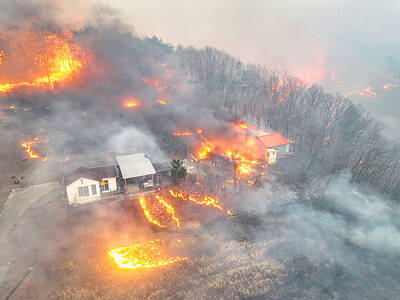
‘HUMAN NEGLIGENCE’: The fire is believed to have been caused by someone who was visiting an ancestral grave and accidentally started the blaze, the acting president said Deadly wildfires in South Korea worsened overnight, officials said yesterday, as dry, windy weather hampered efforts to contain one of the nation’s worst-ever fire outbreaks. More than a dozen different blazes broke out over the weekend, with Acting South Korean Interior and Safety Minister Ko Ki-dong reporting thousands of hectares burned and four people killed. “The wildfires have so far affected about 14,694 hectares, with damage continuing to grow,” Ko said. The extent of damage would make the fires collectively the third-largest in South Korea’s history. The largest was an April 2000 blaze that scorched 23,913 hectares across the east coast. More than 3,000